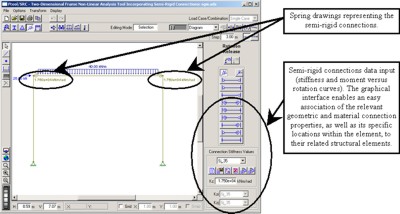
engineering & technology publications
ISSN 1759-3433
PROCEEDINGS OF THE SEVENTH INTERNATIONAL CONFERENCE ON COMPUTATIONAL STRUCTURES TECHNOLOGY
A Non-Linear System for Semi-Rigid Steel Portal Frame Analysis
+Civil Engineering Department, PUC-RIO - Pontifical Catholic University of Rio de Janeiro, Brazil
*Structural Engineering Department, UERJ - State University of Rio de Janeiro, Brazil
Generally non-linear effects are related to the structural elements geometrical and material properties. Recent investigation trends indicated that the non-linear semi-rigid connection response also played a fundamental role in the structural behaviour. This paper describes in detail a structural system, FTOOL/SRC, developed from an earlier program, FTOOL [3] (Two-dimensional Frame Analysis Tool Program) to perform non-linear analysis of semi-rigid steel frames.
The FTOOL/SRC system enables parametric analysis to validate the semi-rigid connection use to be performed in a simple and compact form due to the adoption of an efficient graphical interface and to the use of an external solver FEMOOP [2] (Finite Element Method - Object Oriented Program). The implemented interface combines, in a user-friendly environment, the pre-processing (model creation and manipulation), structural analysis (FEMOOP [2]) and the post-processing phases.
A connection finite element, developed by Del Savio [1], was implemented in the earlier, FEMOOP [2], system and is employed for the non-linear structural semi-rigid analysis. This element enables a plastic hinge analysis to be performed on the structural connections and bars for any type of loading.
The most significant developments of the FTOOL/SRC system were related to three fundamental issues: First the implementation of its graphical interface, enabling non-linear analysis and the semi-rigid connection data input to be performed. Second an evolution from the previous data structure, centred on a complete topological planar subdivision representation, HED (Half-Edge Data Structure), to a new object oriented data structure. Third the implementation of a connection finite element, Del Savio [1], in the FEMOOP system [2].
The object oriented philosophy main advantages are: easy code maintenance and program developments, reduction of the probability of error occurrence and the minimum impact caused by new code implementations on the existing code. Additionally the code reuse also leads to a widely adoption of generic procedures.
The main objective of this paper is to demonstrate, through a series of validating examples, the performance of the FTOOL/SRC system and its implemented strategies, focusing on the newly conceived object oriented data structure.
- 1
- A.A. Del Savio, "Modelagem Computacional de Estruturas de Aço com Ligações Semi-Rígidas", MSc. Dissertation, Civil Engineering Department, PUC-Rio, Brazil, (in Portuguese), 2004.
- 2
- L.F. Martha, E. Parente Jr., "An Object-Oriented Framework for Finite Element Programming", Proceedings of the Fifth World Congress on Computational Mechanics, IACM, Vienna, Austria, Jul. 2002.
- 3
- L.F. Martha, "FTOOL: A Structural Analysis Educational Interactive Tool", Proceedings of the Workshop in Multimedia Computer Techniques in Engineering Education, Technical University of Graz, Austria, pg. 51-65, 1999.
purchase the full-text of this paper (price £20)
go to the previous paper
go to the next paper
return to the table of contents
return to the book description
purchase this book (price £135 +P&P)
